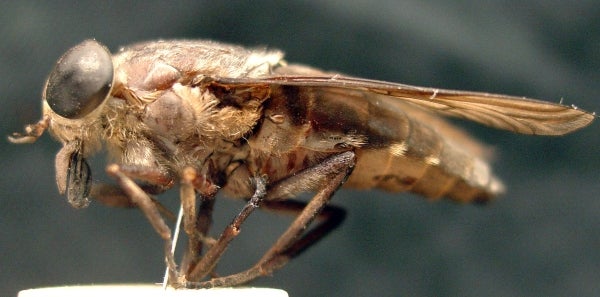Home -> Vectors -> Other Flying Insects -> Tabanids
TABANIDS
Members of the family Tabanidae are nuisance pests for livestock and people, due to their painful and irritating bite, persistent biting behaviour, and blood ingestion (Baldacchino et al., 2014). They can furthermore also be bothersome to wildlife species (Baldacchino et al., 2013). Besides causing economic losses based on direct effects, they are important vectors for a number of disease agents (viruses, bacteria, protozoa, filarial nematodes), including Trypanosoma evansi, which can affect camels and equids causing Surra, but which can also cause trypanosomosis in form of a fatal disease in dogs (Echeverria et al., 2019) and which has been reported in cats (e.g., Tarello, 2005; Misra et al., 2016). The transmission of this protozoan occurs mechanically by tabanid species of the genera Tabanus, Haematopota and Chrysops.

Photograph of adult tabanid
(by courtesy of D.D. Bowman, University of Cornell, Ithaka, NY, USA)
General
Morphology
Feeding
Life Cycle
Prevention
References
GENERAL
Taxonomy
The family Tabanidae comprises more than 4,500 species, belonging to 177 genera, and is divided into four subfamilies: Chrysopsinae, Tabaninae, Adersiniiae and Pangoniinae (Bánki et al., 2023). The first two subfamilies contain most of the economically important tabanids (Mullens, 2019). They are commonly referred to as horse flies, deer flies, or clegs. Tabanids in the subfamily Chrysopinae are called deer flies, with nearly all being members of the genus Chrysops. The term horse fly is generally applied to most of the Tabaninae species, except the tribe Haematopotini. The term cleg is used for Haematopota spp. within the subfamily Tabaninae.
Classification of tabanids
| Phylum: | Arthropoda |
| Class: | Insecta |
| Order: | Diptera (i.e. two-winged insects) |
| Suborder: | Brachycera |
| Family: | Tabanidae |
| Subfamily: | Chrysopsinae, Tabaninae, Adersiniiae, Pangoniinae |
| Genus: | e.g., Chrysops, Tabanus |
Distribution
Tabanids are present on every continent except Antarctica (Mullens, 2019). Large seasonal populations of some species occur as far as 60° N latitude, but they disappear above tree line. Diversity within the family is greatest in the tropics, but moist temperate regions have a rich fauna as well (Mullens, 2019).
Epidemiology
Tabanids possess a wide spectrum of hosts, including wildlife, livestock and men. They are among the most free-living adult flies, which play a role as livestock pests as well as vectors of various disease pathogens. A single blood meal is used as a source of energy for egg production (100-1,000 eggs per meal) in tabanids, and females of certain species can additionally oviposit before a first blood meal is obtained (autogenous). Therefore, the maintenance of annual tabanid populations requires successful oviposition by only 2% of females. This and the life cycle factors that (i) female adults spend only few minutes feeding on a host to obtain enough blood to produce eggs, (ii) tabanids can feed on domestic hosts, but also on wild hosts, which are sufficient blood sources to maintain populations, and (iii) tabanids lay their eggs in a wide variety of sites, and the larvae are ubiquitous throughout the environment (Foil and Hogsette, 1994), makes effective reduction of tabanid population a challenge. In most cases, control of tabanids has to be based on protective measures against adults rather than larvae (Baldacchino et al., 2014).
As mentioned before, tabanids may act as vectors of disease pathogens via mechanical transmission. Here, overall, they have all the characteristics of good mechanical vectors, namely by frequently engaging in interrupted feeding, by being highly mobile and by endowing with large mouthparts (Baldacchino et al., 2014).
Some pathogens and parasites are also transmitted biologically by tabanids, in which cases the disease agent replicates and/or develops within the fly for a period of time prior to transmission (e.g., the filarial nematode Loa loa) (Mullens, 2019).
EXPLORE OUR CONTENT
 CVBD MapsThe CVBD Occurence World Map presents country-specific situations based on current scientific knowledge and feed-back from experts around the world in an easy-to-grasped way. |
| Read more-> |
 ResourcesElanco Animal Health supports education in parasitology and especially in the field of vector-borne diseases. Access image collections, discover the World Forum calendar, interesting links and our glossary. |
| Read more-> |
 CVBD World ForumThe CVBD World Forum is a working group of leading international experts with the mission to enhance knowledge and communication on companion animal vector-borne diseases for the improvement of animal, human, and environmental health. |
| Read more-> |
